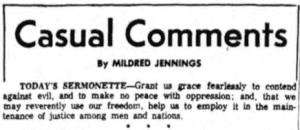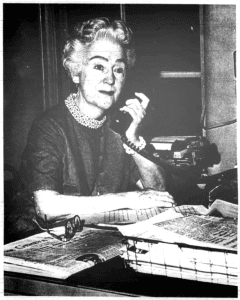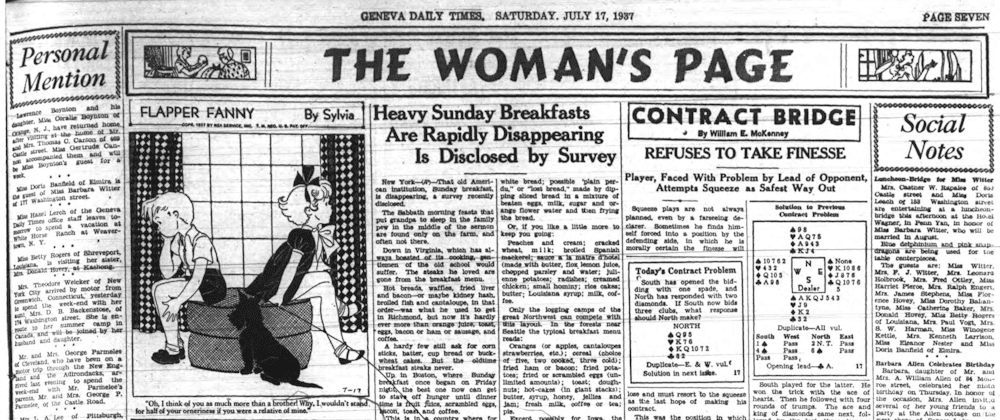Geneva’s Early Woman Journalist: Mildred Jennings
By Anne Dealy, Director of Education and Public Information
If you spend enough time reading the 20th-century issues of the Geneva Daily Times you begin to recognize bylines. One of those I’ve come across over the years while researching the area’s food history is Mildred Jennings. Mildred Jennings was one of the first woman journalists in the area. She worked at the Geneva Daily Times (forerunner of today’s Finger Lakes Times) from 1921 to her retirement in 1969. She was also a correspondent for Rochester’s Catholic Courier Journal.
Mildred was born in 1899, the daughter of Irish immigrants, Thomas A. and Mary Flannery Jennings. She was the oldest of their six children. The census and city directories show that Thomas worked as a laborer for much of her childhood. He eventually secured work at the Seneca Foundry on North Street. By the mid-1920s, he had moved up to shipping clerk. He was able to move the family from their rented house on Middle Street, near the foundry, to a home at 220 Washington Street. Mildred lived here for most of her life.
The children all attended St. Francis DeSales parish school and DeSales High School. Mildred received her diploma in 1917, a member of the school’s second graduating academic class. All her siblings also attended the school. Most remained in Geneva after graduation. Her brother Donald worked for the City’s engineering department. Thomas Joseph worked as a teacher, served in World War II, wrote several books, and was assistant to U.S. Senator Kenneth Keating. Her sister Florence taught in Rochester, then married. Dorothy entered religious life as a Sister of St. Joseph. Pauline was the librarian at the Agricultural Experiment Station.
Mildred attended William Smith and the College of New Rochelle. This was unusual for anyone at that time and more unusual for a woman. All her siblings seem to have attended college as well. She worked for the Times as a college correspondent, then was hired as a staff writer in 1921. In her early days, the newspaper carried weddings, obituaries, and social news. Accounts of weddings included detailed descriptions of the bride’s and bridesmaids’ dresses. Notices announced parties and social events, who was on vacation, and who had house guests. Mildred likely wrote much of this material. Although she also covered general news, her reporting focused on social and cultural matters.
In today’s news industry the journalism Mildred did for the Times is considered features or lifestyle reporting. It’s sometimes denigrated as “soft news” in comparison to the “hard news” of politics and current events. In the 19th and early 20th century, it was considered women’s journalism. Often on a dedicated “Woman’s Page,” women covered the “Four F’s”— family, food, furnishings, and fashion. It was often the only kind of news reporting women journalists could pursue. When Anna Kernan Conboy, another journalist, was offered a position at the Geneva Times, she told the editor she wouldn’t do “women’s work.” One article in the Times in 1919 detailed “What a Girl Can Be: Newspaper Worker.” The female author wrote, “The opportunities for women reporters certainly are not great, because women can’t compete with men. A woman reporter is as much out of place climbing over the ruins of a wreck as in “covering” a murder in the corner saloon. Nor has she the physical strength to endure the pressure and irregular hours.”
Whether Mildred felt constrained by the limitations put on her is unknown. Like many women in her position, she provided useful information to Geneva residents. She wrote stories about schools, churches, and local non-profit and social organizations. She covered the centennials of J.W. Smith and St. Francis DeSales Church, the activities of the Geneva Women’s Club, and wrote pieces on local history. For many years, she reviewed local theater productions, concerts, and lectures. She wrote profiles of individuals, including many women. Often, she interviewed people from other nations who were visiting or living here and exposed Geneva residents to a wider world. She started a column called Casual Comments in the early 1960s. It featured short pieces of wisdom or advice, poems, quotes, humorous stories, and recipes, and ran into the 1970s.
Mildred was also active in many community organizations. She attended St. Stephen’s Church and participated in Catholic women’s groups. She was involved in the Geneva Woman’s Club and the Ontario County Women’s Republican Club, the Geneva Chapter of the American Red Cross, the Geneva Historical Society, and was a founding member of the Zonta Club. She was also a speaker with Pomona Grange, started a short-lived food business with her siblings, and wrote an unpublished book of poetry. Geneva High School gave out an award in her honor to students in journalism in the 1970s and 80s.
Editors and writers of the woman’s page of newspapers shaped the news business in the 20th century. Women like Mildred covered issues and topics of interest to women that might not have been covered any other way. They often brought social issues to the forefront. In the 1950s, Mildred wrote a series on juvenile delinquency and another on substandard housing. Despite the low status of the woman’s page, it’s incredibly useful for historians. It provides information about Geneva’s ordinary people and everyday events that would not otherwise be known.
Mildred Jennings retired in 1969 but continued writing her column and occasional articles for the Times in the 1970s. She died in 1984 and is buried in the family plot in St. Patrick’s Cemetery.




I worked for a community newspaper for seven years so I found the article very interesting! I did much of the same kind of writing as Jennings.
Thank you, Anne for your interesting story about Mildred Jennings.
I enjoy reading stories about people of the past.
Pim
Thank you for this article on Mildred Jennings .
Mildred visited Rose Hill Mansion often in the fall of 1964. My father , Joseph N. Strong had done extensive research on the Roses ,Strongs and Swan families. This included early photographs, furniture and personal items from these early Rose Hill families.
Working closely with my father, Mildred wrote a series of article’s published the last week in October of 1964 .
I remember her frequent visits to Rose Hill .. Your article brought back fond memories of this gracious intelligent lady .